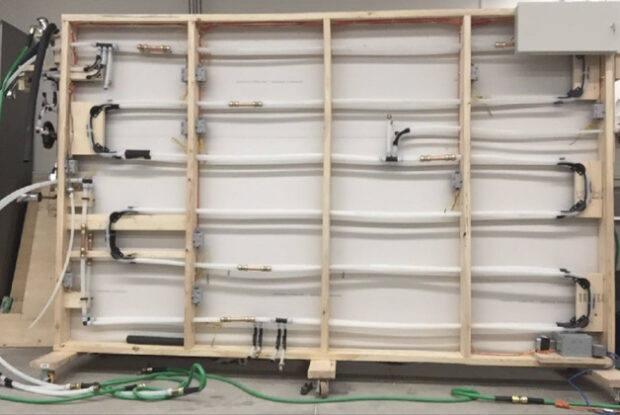Ten years ago this fall, the Algonquin College campus in Ottawa opened the Algonquin Centre for Construction Excellence (ACCE). The 190,000 sq. ft. space was built with the goal of being sustainable, earning it a Leadership in Energy and Environmental Design (LEED) Platinum certification. The ACCE building allows more than 2,500 students in all construction and related design programs to have classes in a single space. It also has many laboratories where students and professors are currently working in collaboration with outside companies for applied research and innovation.
After having been open for 10 years, some minor nuisances and oversights are being addressed. For example, the classrooms can be drafty in the winter and certain parts of the building will have a noticeable temperature difference in the summer.
“Lab space is at a premium. There is much demand for our programs, and some of our programs share lab space currently – for instance plumbing, sheet metal and HRAC. Electrical labs are booked for class time from 8 a.m.-10 p.m. to accommodate all levels and sections of the program,” explains Chris Hewett, professor of Architectural Technology. “It does seem harsh to complain about a 10-year-old building.”
Since January 2019, students of the Building Science program have been working on a project with their professor, Ali Elwafi, to test PEX piping systems. Cross-linked polyethylene (PEX), a type of flexible plastic, is currently replacing traditional copper and galvanized steel as water supply lines. They, in collaboration with their partner company Uponor Ltd., the world’s largest manufacturer of PEX piping, are focused on two main systems, hydronic heating and water delivery. This project focuses on water usage and energy efficiency, as well as the durability of PEX-based systems.
“We so far have managed to engage lots of groups working on their final year project,” Elwafi says. “They have produced really good reports and they have added to their knowledge through these systems.” The hot-water systems that the students worked on are in the M building in room 112, and they will be around for others to visit once it is safe to do so. As for the hydronic-heating systems, they are in a separate shed outside of the M building and are hooked up to a solar system to study the effects of renewable energy.

In the future, designers hope to expand lab space and to implement more projects such as the one run by Elwafi. The second phase of the light-rail train is under construction, with a projected finishing date set of 2025, which will bring a new method of transportation to the college as well as a beautiful new train station right outside of the ACCE. In the fall, there are plans to gather the donors who helped make ACCE a reality, to help them learn about the accomplishments over the last 10 years, such as 17,500 graduates and new programming like Building Information Modelling, Building Automation and Plumbing Techniques.
The ACCE building has undoubtedly helped breathe a lot of new life onto the campus with its emphasis on sustainability as well as its beautiful design, and it will continue to stay on the pulse of what is happening in Ottawa’s construction job market.


